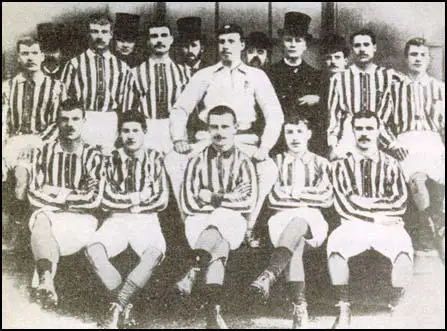Tom Pearson

Tom Pearson was born in West Bromwich in 1866. Pearson played football for Oak Villa and Sandwell before joining West Bromwich Albion.
In the 1886-87 season they beat Burton Wanderers (6-0), Derby Junction (2-1), Mitchell's St George (1-0), Lockwood Brothers (2-1), Notts County (4-1), Preston North End (3-1) to reach the final against Aston Villa. Pearson played on the left-wing but WBA lost 2-0.
WBA was in great form in the 1887-88 season, scoring 195 goals in 58 first-team matches. WBA also enjoyed another good run in the FA Cup beating Stoke City (4-1), Old Carthusians (4-2) and Derby Junction (3-0) to reach the final against Preston North End. A crowd of nearly 20,000 watched the final at the Kennington Oval on 24th March, 1888. The 19-year-old Billy Bassett was the star of the game and after one long dribble he passed to Jem Bayliss who scored the opening goal. Fred Dewhurst scored an equalizer early in the second-half but WBA gradually got the upper-hand. According to Philip Gibbons in Association Football in Victorian England: "Bassett tormented their defence". He eventually provided the cross for George Woodhall to score the winning-goal ten minutes from time.

Albert Aldridge, Charlie Perry, Ezra Horton, Bob Roberts, George Timmins, Harry Green;
front row, George Woodhall, Billy Bassett, Jem Bayliss, Tom Pearson, Joe Wilson.
The first season of the Football League began in September, 1888. WBA's professional players received 10 shillings a week, with no bonuses or expenses. Preston North End won the first championship without losing a single match and acquired the name the "invincibles". West Bromwich Albion finished in 6th place with Billy Bassett ending up as the club's top scorer with 14 goals in 25 games. Second in the list was Tom Pearson who scored 12 in 26.
Preston North End also won the First Division title in the 1889-90 season. WBA finished in 5th place. Top scorer for the club that season was Tom Pearson with 17 goals in 24 games.
West Bromwich Albion struggled in the Football League in the 1891-92 season. Once again Tom Pearson was top scorer with 15 goals in 17 games. However, they did well in the FA Cup beating Old Westminsters (3-2), Blackburn Rovers (3-1), Sheffield Wednesday (2-1), Nottingham Forest (6-2) to reach the final against Aston Villa.
In his book, Association Football in Victorian England, Philip Gibbons argues that: "Villa dominated the early proceedings, with Athersmith and John Devey exerting pressure on the Albion fullbacks. However, the West Bromwich side soon responded as Billy Bassett passed to Roddy McLeod, who crossed the ball to the waiting Geddes. He shot towards the Villa goal and Warner failed to collect the ball clearly. It rolled between the Villa goalposts to secure a surprising one-goal lead for the Albion team."
Billy Bassett was also involved in WBA's second goal. He won the ball on the halfway line and after running at the Aston Villa defence he passed to Alf Geddes. His shot was saved but the goalkeeper could not hold onto the ball and Sammy Nicholls had the simple task of scoring from the rebound. Jack Reynolds scored the third with a shot from 25-yards. Pearson, who played at inside-left, had won his second cup-winners' medal.
WBA finished in 8th position in the First Division of the Football League in the 1892-93 season. Pearson scored 12 in 26 league and cup games. This made him the club's top scorer for the fourth successive season.
Pearson retired from professional football in 1893. During his time at West Bromwich Albion he scored 72 goals in 138 games.
Tom Pearson died in 1918.
